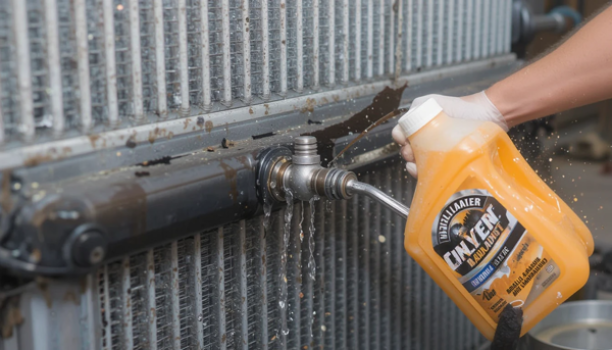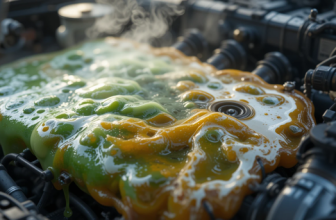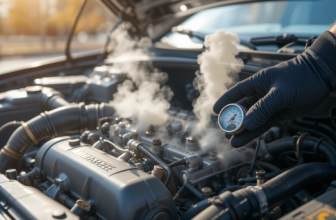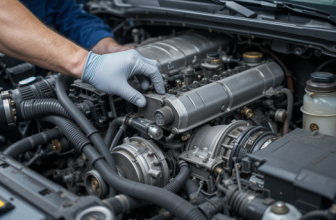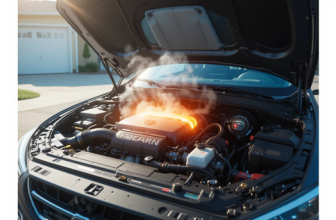How to properly flush a radiator for optimal engine health—learn easy, step-by-step tips to do it yourself and avoid costly repairs.
How to Properly Flush a Radiator 🚗💦
When was the last time you gave your radiator a good flush?
If you just paused to think, it might be time for one. Your car’s radiator keeps your engine cool. But, over time, it gets clogged with grime and rust. This can hurt your car’s performance and even cause engine failure 😱.
Today, we’re going to fix that. We’ll show you how to flush your radiator the right way. This guide is easy to follow, perfect for beginners or anyone who needs a refresher.
Why Flushing a Radiator Is a Big Deal 🔧
Your radiator is more than just a pretty face under the hood. It’s the heart of your car’s cooling system.
- Over time, coolant breaks down
- Rust and debris can clog your engine
- Poor cooling = engine overheating = $$$ in repairs
Flushing the radiator gets rid of old coolant and buildup. This helps your engine run smoother and cooler.
How Often Should You Flush Your Radiator? 📆
Not all cars are the same. But a good rule of thumb is:
- Every 30,000 miles or
- Every 2–3 years
Your owner’s manual will tell you the exact time. But if your coolant looks dirty or rusty? It’s time for a flush.
Signs Your Radiator Needs a Flush 🚨
Not sure if it’s time? Watch for these signs:
- Engine temperature rising above normal
- Brown or rusty coolant
- Low coolant levels
- Sludge buildup in the reservoir
- Heater not working properly
- Sweet smell (coolant leak)
If you see more than one sign? Yeah, it’s time to flush it.
What You’ll Need for the Job 🧰
Here’s your quick checklist:
| Item | Why You Need It |
|---|---|
| Radiator Flush Solution | Loosens rust and grime |
| Distilled Water | Flushes out old coolant |
| New Coolant | Refill with fresh, clean antifreeze |
| Bucket or Drain Pan | Catch old coolant safely |
| Gloves & Eye Protection | Stay safe from splashes |
| Funnel | Helps pour without spills |
| Wrench or Pliers | For loosening drain plug |
Got everything? Let’s move on.
Step-by-Step: How to Properly Flush a Radiator 🛠️
Here’s the breakdown in plain English:
1. Let the Engine Cool Completely ❄️
Never open the radiator cap on a hot engine. The pressure can send boiling coolant flying. Wait until it’s totally cool.
2. Locate the Radiator Drain Plug 🔍
It’s usually near the bottom of the radiator. Place your bucket underneath it to catch the old fluid.
3. Drain the Old Coolant 🪣
Use pliers to open the plug. Let the coolant flow out completely. Keep pets and kids away—antifreeze is toxic but smells sweet.
4. Close the Plug and Add Flush Solution 💧
Pour in your flush solution and fill the radiator with distilled water. Replace the cap.
5. Start the Engine and Let It Run 🏁
Let it idle with the heater on full blast for about 10–15 minutes. This circulates the flush throughout the system.
6. Turn It Off and Let It Cool Again 🌬️
Once it cools, open the drain plug and empty the system again.
7. Repeat the Flush if Needed 🔁
If the fluid looks dirty, repeat steps 4–6 with fresh distilled water. Keep flushing until water runs clear.
8. Add New Coolant 🧪
Once clean, close the plug and refill the radiator. Use a 50/50 mix of antifreeze and distilled water, or pre-mixed coolant.
9. Bleed the Cooling System 💨
Run the engine with the radiator cap off to remove air pockets. Top off as needed once it settles.
10. Check for Leaks and Test Drive 🚘
After everything’s sealed and topped off, take a short drive. Watch the temp gauge and check under the car for leaks.
Coolant Types: Which One to Use? 🧊
| Coolant Type | Vehicle Type | Notes |
|---|---|---|
| Green (IAT) | Older cars (pre-2000) | Needs frequent changes |
| Orange (OAT) | GM & newer cars | Longer-lasting |
| Yellow (HOAT) | Ford/Chrysler | Hybrid formula |
Always double-check your manual for the right type. Mixing the wrong coolant can lead to sludge.
DIY Radiator Flush vs. Mechanic: What’s Better? 🛠️ vs. 🧑🔧
DIY Flush Pros:
- Saves money 💵
- You control what goes in
- Learn more about your car
DIY Flush Cons:
- Takes time ⏱️
- Can get messy
Mechanic Pros:
- Quick and professional
- They’ll check the whole system
Mechanic Cons:
- Costs $100–$150+ per flush
If you’re confident with basic tools, DIY is totally doable.
Mistakes to Avoid When Flushing Your Radiator ⚠️
Even simple jobs can go wrong. Avoid these:
- Forgetting to let the engine cool
- Not using distilled water
- Leaving air bubbles in the system
- Using the wrong type of coolant
- Skipping flush solution—just water isn’t enough
Take your time and follow each step exactly.
Radiator Maintenance Tips to Keep It Clean Longer 🧼
Want to avoid flushing more often than needed? Try this:
- Check coolant levels monthly
- Use only the recommended coolant
- Don’t mix old and new coolant
- Inspect radiator hoses for wear
- Flush every 2–3 years, even if it looks okay
Small habits can prevent big problems later.
Cost Breakdown of a DIY Radiator Flush 💲
| Item | Approximate Cost |
|---|---|
| Flush Solution | $10–$15 |
| New Coolant (1 gal) | $15–$25 |
| Distilled Water (1 gal) | $1–$2 |
| Gloves & Funnel | $5–$10 |
| Total | $35–$50 |
Compare that to a $150 service bill—big savings, right?
Environmentally Safe Disposal Tips 🌎
Coolant is hazardous waste—you can’t just dump it.
- Store used coolant in a sealed container
- Drop it off at your local auto parts store or hazardous waste center
- Never pour it down the drain or on the ground
Being car-smart also means being eco-smart.
Final Thoughts: Take Care of Your Radiator, It Takes Care of You ❤️
Flushing your radiator isn’t rocket science. It’s a smart, doable maintenance task. It protects your engine, saves money, and keeps your ride running smooth. With a little time and care, you’ll feel more confident in handling basic car care—and your vehicle will thank you for it.
So go on—grab your tools, pop the hood, and show your radiator some love.
FAQs
How do I know if my radiator is clogged or dirty?
If your engine overheats, coolant looks rusty, or your heater blows cold air, your radiator may be clogged.
What happens if I don’t flush my radiator regularly?
Built-up sludge can cause overheating, damage your engine, or lead to costly repairs over time.
Can I flush a radiator without a flush kit?
Yes, you can flush it with just distilled water and flush solution—no fancy tools needed.
Is it OK to use tap water in a radiator flush?
No. Tap water contains minerals that can cause scaling. Use distilled water only.
How long does a radiator flush take to complete?
Plan on 1 to 2 hours from start to finish, depending on how dirty the system is.
References
https://www.caranddriver.com
https://www.autozone.com
https://www.familyhandyman.com

